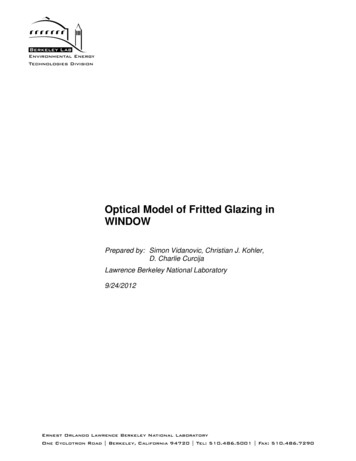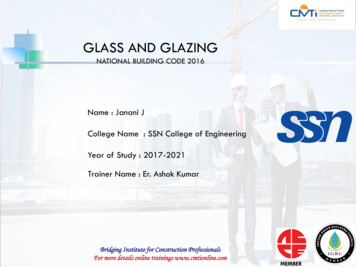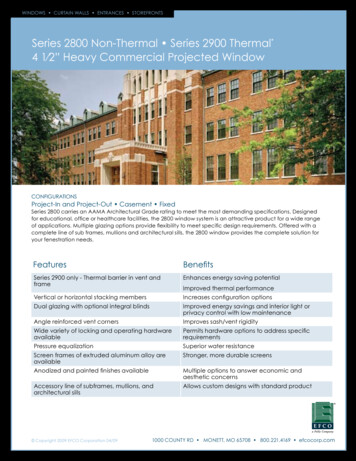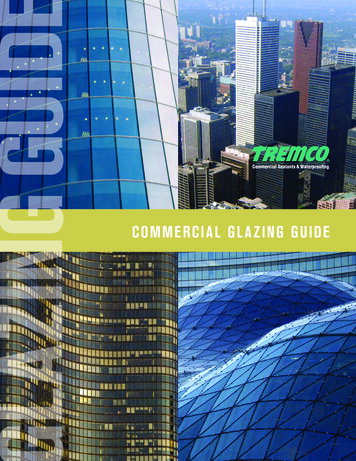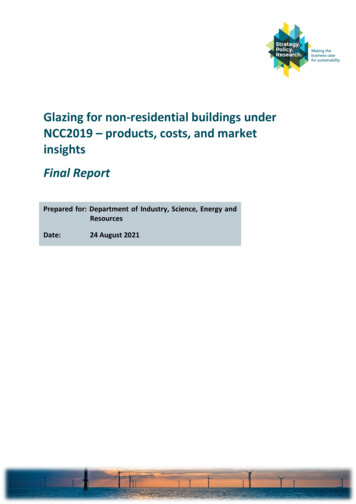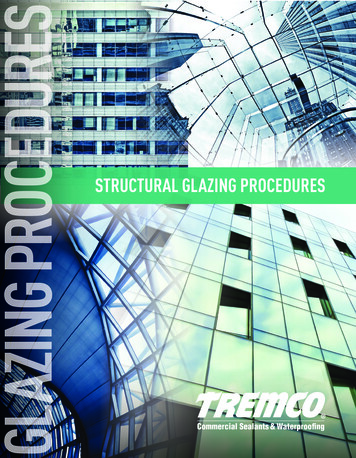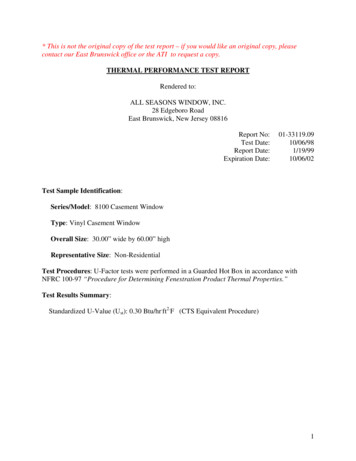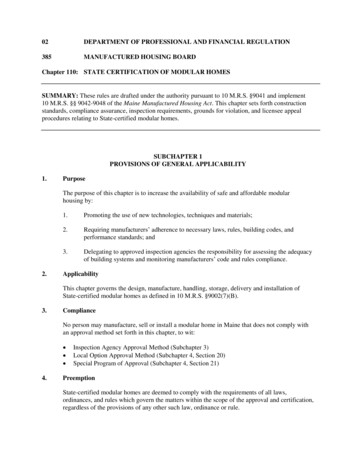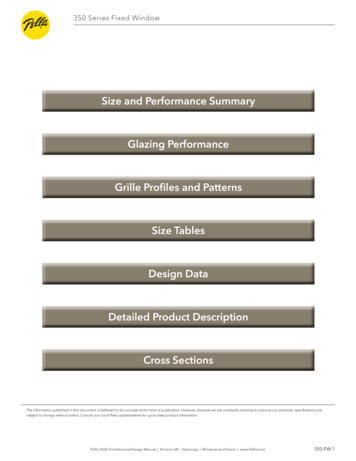
Transcription
View metadata, citation and similar papers at core.ac.ukbrought to you byCOREprovided by Elsevier - Publisher ConnectorAvailable online at www.sciencedirect.comScienceDirectEnergy Procedia 78 (2015) 394 – 3996th International Building Physics Conference, IBPC 2015Development of glazing systems with silica aerogelUmberto Berardi a*aDepartment of Architectural Science, Ryerson University, 350 Victoria Street, Toronto, ON, M5B 2K3, CanadaAbstractThe implementation of innovative materials for energy saving is among the most compelling topics in the building sectorworldwide. In this regard, silica aerogels have received an increasing interest in the last years thanks to their exceptionally lowthermal conductivity, generally around 0.01-0.02 W/(m·K). Aerogel panels laminated to drywall boards have started being adoptedin highly energy-efficient buildings. However, the most promising application of silica aerogels seems to be in highly-insulatingglazing systems. During the last years, double pane glazing systems with both granular and monolithic aerogel in the glass cavityhave been developed and tested. Firstly, this paper reviews existing glazing systems designed with monolithic panels or granularaerogel and show their possible applications. Constrains of these systems, such as the low light transmissibility, cost, and fragility,are discussed. Then, the paper describes the development of a glazing system designed for the retrofitting of an educational building.Lighting and energy simulations allowed comparing window design options with different percentages of glazing area with aerogel.The analysis of the tradeoff between the goals of guaranteeing sufficient daylighting, clear perception of the external environment,and energy saving helps finalizing the design of the new monolithic aerogel glazing system. sevierby byElsevierLtd.Ltd.This is an open access article under the CC BY-NC-ND licensePeer-reviewunder responsibility of the CENTRO CONGRESSI INTERNAZIONALE 4.0/).Peer-review under responsibility of the CENTRO CONGRESSI INTERNAZIONALE SRLKeywords: aerogel; energy saving; glazing systems; trasparent thermal insulation1. IntroductionThe increase of building energy consumptions driven by the higher expectations for indoor comfort, together withconcerns for the rise in GHG emissions, are pushing the research and design interest toward energy saving in buildings.In this context, the development of new insulating materials is among the most promising options [1-3]. This paper* Corresponding author. Tel.: 1-416-979-5000 (ext. 3263); fax: 1 416 979 5153E-mail address: uberardi@ryerson.ca1876-6102 2015 The Authors. Published by Elsevier Ltd. This is an open access article under the CC BY-NC-ND nd/4.0/).Peer-review under responsibility of the CENTRO CONGRESSI INTERNAZIONALE SRLdoi:10.1016/j.egypro.2015.11.682
Umberto Berardi / Energy Procedia 78 (2015) 394 – 399395focuses on the development and characterization of new glazed units which incorporate aerogel monolithic panels andgranules as replacement of the air-gap in double-pane windows.The aerogels are considered one of the most promising family of materials for insulating purposes, given their highthermal insulation [2,3]. They are dried gels with such a high porosity that they have lower thermal conductivity thanair [4]. Moreover, they are nontoxic, low flammable, lightweight, and air permeable. The synthesis of these materialswas discovered in the early 1930s and since that time, several products have been developed, mainly using silica as araw material [5]. The production process of silica aerogel aims to build sufficiently rigid materials with the sameporous texture as that of the wet sol-gel stage. The aging of the gel and its drying are the two most risky phases of theproduction of aerogels, and are responsible of their high cost [6].Due to the small pore sizes, aerogels have thermal conductivity in the range of 0.01-0.02 W/m·K, resulting from awell-balanced relationship among the low solid skeleton conductivity, the low gaseous conductivity, and the lowradiative infrared transmission. This balanced relationship among the different heat transfer modes is hard to achievebecause each heat transfer mode is tightly coupled with the others [7]. Although dense silica has relatively high thermalconductivity, silica aerogels have a small proportion of solid silica. Also, the inner skeleton structure of aerogels hasmany dead-ends, resulting in ineffective heat transfer paths. Finally, the Knudsen-effect which expresses the gaseousconduction in a porous media explains the low gaseous conductivity in aerogels.The solid microstructure of the aerogels has been described as “beads on a string” or “pearls on a necklace” referringto the roughly spherical particles connected by small necks or thin strands. This structure is much less stiff than thatof an open-cell foam (up to 30 to 50 times lower [8]). After cost, the main limitation that is preventing aerogels frombecoming more widely used in the building sector is hence their high fragility. Their fragility has hence suggested theuse of aerogels in protected compartments. Given their good light optical properties, aerogels have been consideredfor building fenestration systems since the 1980s. Products with aerogel in the interspace between the window paneshave shown to provide high thermal resistance and light transmittance.Two types of aerogel exist, the monolithic and the granular aerogels. Monolithic silica aerogels have higher solartransmittance than granular ones; for example, 10 mm monolith translucent silica aerogel windows have shown a solartransmittance up to 0.8, whereas the maximum solar transmittance of granular silica aerogel windows is around 0.5[9-11]. However, cracks often occur when manufacturing large pieces of monolithic aerogels, so glazing systems withmonolithic aerogel have not yet been used beyond research prototypes [12]. A monolithic aerogel window withvacuum glazing and a 13.5 mm thick aerogel panel was developed within the EU project HILIT; this project provedthe possibility to realize windows with a thermal conductivity of 0.66 W/m2K and a light transmissibility above 0.8.Since then, Airglass AB, the firm that provided the aerogel in the HILIT project, has continued refining the productionprocess of monolithic panels.After that preliminary experiences during the HILIT project, many more studies have been done to investigate thepossibility to introduce aerogel in glazing systems. Buratti and Moretti compared several aerogel glazing systemsaccording to their thermal and lighting performances [9,11]. Results showed that compared to double low-e glazing,monolith aerogel windows guaranteed 55% reduction in heat losses and 25% reduction in light transmittance, whereasgranular aerogel windows showed 25% reduction in heat losses, and 66% reduction in light transmittance.Other laboratories and companies currently active in the development of monolithic aerogel panels are Japan FineCeramics Center, Aerogel Technologies, Gyroscope, Guangdong Alison Aerogel, and Surnano Aerogel Inc. However,given the fragility of large monolithic aerogel, it remains difficult to produce reliable monolithic aerogel windows.Currently, the maximum size of a crack-free monolith silica aerogel panel is 0.6 m x 0.6 m [2,5].Although monolithic aerogel panes show some higher performances, granular silica aerogels suffer less the fragility,and although they have a lower light transmissibility, they have been the only ones incorporated in glazing systemsincluded in buildings. The size of most common translucent aerogel granules range between 1 mm and 4 mm. Mostof the granular aerogel is manufactured by Cabot Corporation, a US company located in Boston, MA. The companyproduces two kinds of product: Enova, with a granule size of 2-1200 μm and a U-value of 0.012 W/m2K, and Lumira,with granule size of 0.7-4 mm and a U-value of 0.018/0.023 W/m2K. Nowadays, several window manufacturersproduce granular aerogel window systems incorporating Lumira in the glass cavity. Table 1 reports some technicaldata for the aerogel window systems with the largest diffusion. First experiences have shown that fully aerogel systemsare reasonable only in skylight windows, whereas for façade applications aerogel windows and traditional transparentwindows are generally alternated in order to maintain a clear outside view in some portions of the window (Fig. 1).
396Umberto Berardi / Energy Procedia 78 (2015) 394 – 399Table 1. Technical data for currently commercialized aerogel window products (info obtained directly from the websites).ThicknessU-value W/(m2K)Tviswebsite25.4 mm (1”)44.45 mm (1.75”)76.2 mm (3”)10 mm16 mm25 mm40 mm1.140.610.310.260.170.110.0910% - 45%9% - 40%7% - atasheet.pdfKalwall(glazed windows)60 mm0.3012% - 20%http://kalwall.com/aerogel.htmOkalux(glazed windows)4/30/4 (30 mm)4/60/3 (60 g/images/Produkte/Marken/Prospekte/OKAGEL klein 2012.pdfPilkington(Profilit TGP)16 mm25 arbonate)16 d Glazing Ltd(glazed .com/lumira-aerogel/Fig. 1 – Two examples of built projects in which granular filled aerogel windows have been alternated to traditional transparent windows: DetroitSchool of Arts, MI, USA (left), and Nobel Halls at SUNY Stony Brook, NY, USA (right).2. Development and characterization of an aerogel windowAirglass AB monolithic panels were selected for developing the window units described in this paper. The mainreason for the selection of Airglass AB aerogel was the ability of the manufacturer to produce crack free 0.4 m x 0.3m aerogel panels. The glazing system was composed of a 14 mm monolithic silica aerogel panel between two 4 mmglass panes. For this project, the aerogel windows were not evacuated, so a less than optimal thermal insulatingperformance was expected. However, thermal aspects are not the focus of the present paper.The transmittance of the monolithic panel and of the panel between the glasses was measured using an AgilentCary Series UV-Vis-NIR spectrophotometer between the 200nm and 2000 nm, with a 1 nm accuracy, without usingan integrating sphere. Each measurement was repeated three times. Multiple tests were performed in order to considerthe influence of different sample position. The results of light transmissibility were practically the same in every test.Fig. 2 shows the average values among the tests of the transmissibility of the monolithic panel alone or between twoglass panels at each wavelength. The results show a remarkable light transmissibility, especially in the high spectrumrange. The small discontinuity around 700 nm derives from a beam change in the equipment testing, whereas the dropsaround 1300 nm and 1800 nm are related to the light absorption of CO 2 (high absorption at 1437 and 1955 nm) andwater vapor (high absorption at 1200, 1470, and 1900 nm). The lack of an integrating sphere was considered alsoresponsible for the strong absorption in these bands.
397Umberto Berardi / Energy Procedia 78 (2015) 394 – c Aerogel Panel0.2visible range0.1Monolithic Aerogel in glass 08007006005004003002000wavelenght (nm)Fig. 2 – Light transmissibility of a 14mm aerogel pane alone (dotted line) or among two 4 mm thick clear float glasses (continuous line).In order to evaluate the performance of the window units, light transmittance τv (in wavelength range from 380 nmto 780 nm) and solar direct transmittance τe (in the wavelength from 780 nm to 2500 nm) were calculated accordingto the ISO 9050 [13]. In particular, the light transmittance of a sample was calculated as:߬௩ ൌσళఴబయఴబ ഊ ఛሺఒሻ ሺఒሻ(1)σళఴబయఴబ ഊ ሺఒሻin which Dλ is the relative spectral distribution as given by the standard, V(λ) the spectral luminous efficiency forphotopic vision defining the standard observer, and λ the wavelength of analysis (in this case equal to each nm).The light transmittance of the window with the monolithic aerogel was assessed to be 0.6. The test was alsorepeated for a window filled with 2mm granular aerogel and the result of the direct light transmissibility was equal to0.3. This results confirms the higher transmissibility achievable with monolithic aerogel, respect to granular aerogelsystems, as evident also in Fig. 3 which allows comparing the effect of the size of the aerogel granules. For thefollowing simulations, it is important to mention that testing the double glass unit without the aerogel, a lighttransmittance of 0.7 was measured.a)b)c)Fig. 3 – View through a 14mm monolithic pane and granular aerogel (a); sample of a glazing system with a 14mm aerogel pane in the cavity (b)and with aerogel granules of different sizes, smaller than 2mm granules above and larger granules below (c).
398Umberto Berardi / Energy Procedia 78 (2015) 394 – 3993. Aerogel window in a retrofitting projectThe possible use of the aerogel glazing system in an educational building located in Massachusetts (US) wasanalyzed. Although a change in the window systems is often considered not the best strategy for building retrofittinggiven the high cost of fenestrations, it was decided to act on these elements for the following reasons: the buildingenvelope of this old building had a poor insulation performance, especially for the single clear glass windows (Ufactor equal to 5.8 W/m2K); the poor state of conservation of the windows also generated significant air drifts (ablower door fan test resulted in air infiltration values of 15 cm2/m2 at 50 Pa); the building was in use every day of theyear, hosting many activities also during the summer, so it was unlikely to close it for long time for deep retrofittinginterventions, and only a quick intervention was possible.The solar transmission of the existing windows was estimated to be 0.82, so the adoption of glazing systems withmonolithic aerogel would have reduced appreciably the daylight penetration into the building. The design of the newwindows aimed to preserve the original design of the typical New-England windows, which consisted of 25 individualrectangular glasses, each with a dimension of 0.4 m by 0.3 m.Figure 4 shows the four designs with the different rates of aerogel window replacements: 40%, 60%, 80%, and100% of panels within aerogel in the double glass units. The design tried to preserve a clear view to the outside byhaving no aerogel filled the window at eye height and at the center of the window. Moreover, considering that onlythe central bottom part of the window is currently openable, the selection of the panes for aerogel inclusion tried toavoid movable parts of the window in order to limit the risk of cracks of the fragile aerogel panes.Original40% Aerogel60% Aerogel80% Aerogel100% AerogelFig. 4 – Possible New England window configurations with different percentages of window areas with monolithic aerogel in the cavity.4. Daylight availability with aerogel windowsDaylight analysis were performed with the software DIVA (Design Iterate Validate Adapt) [14]. Among thepossible indices for lighting assessment, the Useful Daylight Index (UDI) was selected. This index measures thepercentage of time in which the daylight illuminance level is sufficient and useful for occupants. In literature, valuesbelow than 100 lux are considered ‘too little’, while values above 2000 lux are considered ‘too much’, with risk ofvisual discomfort or glare. So, the illuminance levels between 100 and 2000 lux are often considered useful in theevaluation of the UDI [15]. For the scope of this study, four corner rooms were considered in order to test the impactof the new windows for the different orientations. Square grids of 0.45 m were evaluated at 0.85 m off the floor.Figure 5 reports the UDI with single pane windows (existing case) and double pane windows (possible retrofitting).In room 1 (facing south-east), with single clear windows, the average UDI over the year resulted 34.8%. In room 2(facing south-west), the installation of double glass window would decrease the amount of excessive daylight in ayear, as shown by the fact that the UDI is higher for double glasses than for a single pane. In room 3, which is mostlynorth facing, the installation of double window would decrease the UDI. Obviously, the overall daylight performanceis affected also by the geometry of the room, as proven by the fact that the rooms that extends deep into the building,(room 3) have overall poorer UDI than small rooms, such as room 4. Figure 5 also shows the UDI in case of adoptionof windows with 40% or 60% of aerogel. The overall trend of UDI in these cases was a small decrease with a higheramount of aerogel. However, the UDI reduction was relevant only far from the windows and only in the largest room(room 3). Comparing the results with double glasses and 40% of aerogel, it emerges a really similar daylight effect.
Umberto Berardi / Energy Procedia 78 (2015) 394 – 399a)c)b)d)Fig. 5 – Useful Daylight Index with single pane windows (a), double pane windows (b), 40% aerogel windows (c), and 60% aerogel windows (d).The results of this study prove that the windows with 40% of aerogel were a valid solution for this retrofitting project,being able to increase significantly the resistance value with advantages also for the daylight quality.References[1] GhaffarianHoseini A, Dahlan N, Berardi U, GhaffarianHoseini A, Makaremi N. Sustainable energy performances of green buildings: a reviewof current theories, implementations and challenges. Renewable & Sustainable Energy Reviews 2013;25:1–17.[2] Jelle P. Traditional, state–of–the–art and future thermal building insulation materials and solutions – Properties, requirements and possibilities.Energy and Buildings 2011;43:2549–2563.[3] Cuce E, Cuce PM, Wood JC, Riffat SB. Toward aerogel based thermal superinsulation in buildings: A comprehensive review. Renewable andSustainable Energy Reviews 2014;34:273–299.[4] Husing N, Schubert U. Aerogels–airy materials: chemistry, structure and properties. Angewandte Chemie International Edition 1998;2:22–45.[5] Jelle B, Hynd A, Gustavsen A, Arasteh D, Goudey H, Hart R. Fenestration of today and tomorrow: A state–of–the–art review and futureresearch opportunities. Solar Energy Materials & Solar Cells 2012;96:1–28.[6] Soleimani DA, Abbasi MH. Silica aerogel: synthesis, properties and characterization. J Mater Process Technol 2008;199:10–26.[7] Baetens R, Jelle BP, Gustavsen A. Aerogel insulation for building applications: A state–of–the–art review, Energy and Buildings 2011;43:761–769.[8] Neugebauer A, Chen K, Tang A, Allgeier A, Glicksman LR, Gibson LJ. Thermal conductivity and characterization of compacted, granularsilica aerogel. Energy and Buildings 2014;47–5779[9] Buratti C, Moretti E. Experimental performance evaluation of aerogel glazing systems. Applied Energy 2012;97:430–437.[10]Gao T, Jelle BP, Ihara T, Gustavsen A. Insulating glazing units with silica aerogel granules: The impact of particle size. Applied Energy2014;128(1):27–34.[11]Buratti C, Moretti E. Lighting and Energetic Characteristics of Transparent Insulating Materials: Experimental Data and Calculation. IndoorBuilt Environment 2011;20:400–411.[12]Schultz JM, Jensen KI, Kristiansen FH. Super insulating aerogel glazing. Solar Energy Materials and Solar Cells 2005;89:275–285.[13]ISO 9050, Glass in building -- Determination of light transmittance, solar direct transmittance, total solar energy transmittance, ultraviolettransmittance and related glazing factors, 2003.[14]Jakubiec AJ, Reinhart CF. DIVA 2.0: integration daylight and thermal simulations using Rhinoceros 3D, DAYSIM and EnergyPlus. In: Proc.of Building Simulation 2012.[15]Berardi U, Wang T. Daylight simulations in an atrium–type house. Building and Environment 2014;76:92–104.399
produces two kinds of product: Enova, with a granule size of 2 -1200 and a Uμm -value of 0.012 W/m 2K, and Lumira, with granule size of 0.7-4 mm and a U-value of 0.018/0.023 W/m2K. Nowadays, several window manufacturers produce granular aerogel window systems incorporating Lumira in the glass cavity. Table 1 reports some technical
